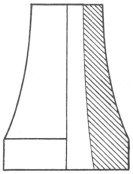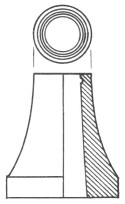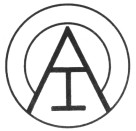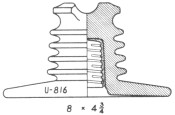Porcelain Insulator News
by Jack H. Tod
Reprinted from "INSULATORS - Crown Jewels of the Wire", August 1975, page 23
Preferably direct porcelain news items and questions directly to Jack H. Tod,
3427 N. 47th Place, Phoenix, Ariz. 85018. All mail will be answered if reply
stamp is enclosed, and the most newsworthy items and questions of general
interest will be published as space permits.

Dear Jack:
I have a U-403 that is quite strange in that it doesn't have the usual Lapp
marking with date and the L-I trademark, but instead has just the name LAPP
stamped around the skirt four times, equally spaced. What is your opinion on
this marking?
Ed Stoll,
LeSuer, Minn.
- - - - - - - - -
Dear Ed:
Several others have asked the same question in the past year or so. I don't
have the slightest idea why Lapp did this, but they must have had a good reason,
since it obviously took more time to do it that way. Since these were made in
the early 1930's we'll probably never know the answer from factory records or
Lapp workmen.
Jack

Hi Jack:
In the November 1974 CJ column you mention a U-388 Helmet Dee Willett got
from me. I have had others of these and also I have a brown, wet process U-297A
(Similar) which has this identical large S stamped into the crown. I think these
were maybe used on the old Portland Traction Company lines but I have no way of
knowing for sure. I'm sending to you one each of these S specimens for your
reference and retention.
I haven't found too many odd insulators in and around Portland. The good
ones seem to be in the Seattle area. They used a lot of butterscotch colors and
Pittsburg MLOD in that pretty light blue, all very old and crude.
Chuck Irwin,
Portland
- - - - - - - - -
Dear Chuck:
Many thanks for the specimens, and these definitely are Thomas items. We'll
probably never know why they were just stamped with that large S instead of the
THOMAS seen on most of these same insulator styles made by Thomas. This S is a
very characteristic type style quite unlike any S I've ever seen in other Thomas
marking stamps.
(Note: Chuck specializes in white porcelain, and anyone wanting one of the S
items might contact him for a swap).
Jack

Dear Jack:
My friend has this porcelain insulator pin base and, not having any reference
on porcelain insulators right now, I know nothing about it. Could you give me
some information on it such an value use, patent date, etc.?
It's approximately 4" tall, 3" wide, tan glaze, unglazed top and
bottom. It has on the bottom a handstamp marking PAT'D MAR. 13, 1893 / Fred M.
Locke
Steve Fujimoto
Altadena, Cal.
- - - - - - - - -

Dear Jack:
Recently I received an insulator found along the old Telluroid (Telluride?)
line near Provo, Utah. This porcelain sleeve was on a pin between the wooden cob
and the pole top "ridge iron" on which it was mounted. The bolt has a
round head above the wooden part with two small bosses pinched out on the shaft
part so that it won't turn inside the cob. There is a reddish compound between
the bolt and sleeve. It is 3" tall, 2-5/8" wide at the base, unmarked,
mottled light and dark brow glaze except for the bottom and top surfaces. The
top surface has several concentric grooves cut in as I showed in my sketch.
Can you give me any information on it? Who made it? It's use? Vintage? Etc.?
Doug Bushnell
Salt Lake City
- - - - - - - - - -
We've run the answer to this at least once before (see May 1972 CJ, page 15),
but it's time for a rerun with the question asked a dozen more times -- twice in
one mouth.

As pictured immediately above, these are "porcelain base pin
assemblies". These were sold complete as show here, ready to install.
They were originally a creation of Fred Locke, and the patent involved is
#493,434 of March 14, 1893 (note the March 13 error in the marking stamp). The
idea was to effectively lengthen the flashover distance from the conductor to
the crossarm pin bolt.
The small bosses on the bolt under the head keep the wooden cob from turning
on the bolt to facilitate tightening the nut when installing and also so the cob
will not turn when screwing on or off the insulator. The concentric ridges and
grooves on the top surface on some (not all) of these porcelain bases are a
friction device to keep the porcelain and wooden parts properly aligned.
Subsequent to the 1910 patent expiration, these pin assemblies were made and
sold by other companies, notably Illinois and Ohio Brass, possibly until the
late 1930's. They come in a great variety -- size and length of the porcelain,
size and length of threaded cob, length of the bolt, etc. They are procured just
as any other poleline hardware item (poles, crossarms, brackets, wire, etc.) and
have nothing to do with the procurement of the insulators. The only requirement
is that the pin size and style must be compatible with the insulators bought for
the line.
Porcelain base pins have some collector appeal as a "related item",
and the complete pin assembly is very much more desirable than just the
porcelain part of it. Value would range from very little for unmarked porcelain
bases alone up to maybe $20 or more for complete assemblies of early vintage
with Fred Locke marking & in good condition. Anything in between these
extremes would be valued on a "what you can get for it" basis.
Jack
(June) I just received my advance complimentary copy of the porcelain
commemorative item for the National Insulator Association 6th Annual Convention,
and these are really things of beauty. They are a hollow cast item, butterscotch
glaze, identical shape to the U-390 Locke roman helmet, slightly reduced in
size. Dick Alumbaugh really did a splendid job on these. See June CJ, pages 4-5
for complete description.
This is another example of the producer of such items working closely with
the NIA to evolve a design which is a creditable addition to our collectible
items and yet not being classed as "objectionable" because of being
alterable to simulate a genuine insulator.
(Note: For those not getting to San Diego, the balance of the 500 serial
numbered specimens are for sale by mail while they last. See ads in CJ.)
Jack
Dear Jack:
In the February 1975 issue of Crown Jewels, you sent out a plea for
information on the Buller's Limited trademark. I have several Buller's
insulators marked "London" so I wrote to my cousin, Michael
Griffith-Jones (a delightful Welshman complete with monocle); he is an officer
in the House of Commons in London, England. As a result of his contacts, I
received a letter and brochure from Stoke-on-Trent which I think will be of
interest to you and our fellow collectors.
During my visit to England in November 1974, I was fortunate to obtain a
couple dozen different porcelain insulators but so far I have not been able to
locate them in your book or supplements.....
Major Alex J. Burnett
Vermilion, Alb.,
Canada
- - - - - - - - - -
Dear Alex:
All CJ readers are indebted to you for your pursuit of this information, and
selected portions of your transmitted material are included below. Of the
numerous foreign porcelain manufacturers of insulators, these English ones are
of greatest interest to collectors since their insulators found use around the
world. Many collectors have specimens undoubtedly made by these firms.
Your insulators are not in my book because it is necessarily limited to items
of U.S. manufacture. Insulator collecting is evidently only a U.S. and
Canadian fad, and I know of no person over here who has the energy, time or
purpose to travel the world and spend several years researching the numerous
foreign insulator manufacturers and their products of the last 100 years. We
continue to be quite ignorant about the subject.
Jack
Allied Insulators Limited
Brief History of the Company
ALLIED INSULATORS LIMITED was formed in 1959 by the amalgamation of Bullers
Limited with Taylor Tunnicliff & Co. Limited, two of the largest electrical
porcelain manufacturers in the United Kingdom. It was a fitting merger, for the
history of each company follows a remarkably similar pattern of progress and
technical development during the last 100 years.
The story starts in the year 1840 with the foundation of a small family
pottery business by Mr. John Buller in the pleasant Devon village of Bovey
Tracy. The main products of this firm were "spurs and stilts" or kiln
furniture, an important accessory in the firing of pottery ware even today, and
a ready market existed for these items in North Staffordshire where the large
English potteries were already established. It was not surprising, therefore,
that after a few years of development, this family business was, in 1865, moved
from Devon to Hanley in Stoke-on-Trent to be at the centre of the pottery
industry.
With the coming of the Electrical Age, the company, using considerable
foresight, commenced production of electrical insulators, and by 1868 was
established as a supplier of insulators complete with ironwork.
Development continued rapidly and the Company, working in close cooperation
with an Electrical Engineering firm of the time, was associated in the design
and development of many low tension insulators. The specification for the screw
thread inside a telephone insulator, together with the supporting spindle was
developed by co-operation between the Company and Mr. J. H. Cordeaux, after whom
the screw thread is named. It is interesting to note that this specification is
still in use today. Also a telephone insulator designated T.129 was first
supplied to the British Post Office in 1887 and apart from slight modification,
this same insulator design is still in current use throughout the world.
In 1885 the metal foundry of Jobson Bros. at Tipton in Staffordshire was
purchased, and the new Company, Buller Jobson & Co. Limited was formed. Then
in 1890 the firm became a public company and the name was changed to Bullers
Limited.
The other branch of the family was established in 1867 when an engineer by
the name of Thomas Taylor and a potter, William Tunnicliff, went into
partnership. They combined the skills of potting with that of engineering, to
specialise in the manufacture of pottery having a high degree of dimensional
accuracy, a feature uncommon in general pottery at that time. They opened a
small factory at Shelton, near Hanley, Stoke-on-Trent, for the manufacture of
ceramic door furniture, handles, lamp containers, hermetically sealed jars, etc.
All items were associated with metal parts thus requiring a certain amount of
precision in production. It was not long before the factory at Shelton became
too small and production was transferred to larger premises at Eastwood, Hanley.
After the retirement of William Tunnicliff in 1895 a Private Limited Company was
formed.
It was towards the end of the 19th century, whilst the electrical age was
still in its infancy, that both Companies embarked upon the specialised
production of insulators. Steady progress followed. Bullers Limited built a new
factory at Milton, just outside the Potteries, and production started in 1920.
Taylor Tunnicliff & Co. Limited erected a new factory at Stone in
Staffordshire where they commenced manufacture in 1922. In 1926, a factory was
obtained by Taylor Tunnicliff at Longton, in the Potteries, and this plant was
utilised for the production of ceramic refractory formers for electric fires,
cookers and other heating appliances. Yet another factory was obtained in 1928
in Hanley, known as Electric and Ordance Accessories & Co. Limited, where
small turned ware and die-pressed insulators were produced.
Both the new factories at Milton and Stone were designed for production of
high voltage insulators, and development and enlargement has been necessary at
both plants during the passing years in order to keep abreast of the demand for
ever larger insulators. A series of extensions, which took place at Stone and
were completed in 1951, doubled the original output whilst the most recent
expansion programme at Milton was only completed in 1967, after the two
companies had amalgamated.

Alex also enclosed the above postal cancellation used by the company, and it
should be of interest to collectors because of their trademark in it.
The logo used by Allied Insulators Ltd. is shown at the right. Keep this in
mind, since it wouldn't be unusual for insulators to turn up some day with a
marking based on this logo.


Dear Jack:
In the Hartford Faience Co. insulators, I have the A105 (hat distribution),
A106, A107 and A108 (3 cable types) and the A115 (3" closed-end strain). Do you know if they started with
A100 and what
the numbers went up through?
Lew Hohn,
Rochester, NY
- - - - - - - - -
Dear Lew:
All Hartford items I've seen have their H trademark plus the catalog number
like the example above. Here are numbers from the Hartford catalogs I have; some
missing numbers may have been made but not cataloged.
- A105 = U-292A or somewhat similar
- A106 = U-627
- A107 = U-464A
- A108 = U-645
-
A109 = U-722A
- A110 = U-731 (A111 with 1-3/8" pin)
- A112 = U-751 Sim (A113 with 1-3/8" pin)
- A128 = U-363
- A130 = U-503 Sim (4" tall)
- A147 =
U-399A
- A605 = U-528 or U-529A (A606 with 1-3/8" pin)
- A607 = U-529 or
approx. (A608 with 1-3/8" pin)
- A117 - standard 3" secondary rack spool
Strains are: A99, A100, A101, A102, A103, A114, A115, A116, A118, A119, A133,
A134, A135.
Multipart pin types are: A157, A160, A163, A189, A287
Suspensions are: A124, A125
Jack

Dear Jack
My porcelain insulators were driving me crazy. I just couldn't catalog them
sensibly, so I traded all 358 of them for glass insulators with Ed Allander
(Duncannon, Pa.).
Since then, I have collected a few more and one in particular is a Locke
which I have never seen before. Would you kindly look it up for me?
Henry Novroski,
Swoyerville, Pa.
- - - - - - - - -
Dear Henry:
Don't let the porcelain insulators drive you crazy; just buy the standard
reference books on porcelains and catalog them like everyone else. I presume you
are not trying to understand or catalog your glass insulators without obtaining
the primary reference books on glass insulators. I consider several of them
indispensable, and Woody's CD- chart as indispensable as the porcelain U- chart
is for cataloging the hundreds of styles.
Your insulator here is old hat to porcelain collectors since it's just one of
the 939 porcelain pin type shapes in the porcelain U- chart (Universal Style
Chart).
This is a U-816. Locke also cataloged a 10" version (U- 816A) and a
11" version (U-816B). They billed them as their "TOUGHTYPE"
Hi-Tops, and they came about from the experience that flat disc suspension units
were less often damaged by malicious acts than were pin types. The large U-816
skirt has no electrical function and is there solely to ward off the bullets and
rocks from down below.
The Locke factory drawings for this series are dated Feb 9, 1933 and
contained seven sizes. The 6-1/2", 9", 12", and 14" sizes
were not cataloged, so we didn't put them in the U- chart. If any of those ever
do turn up as having been made, we'll put them in the chart.
Since I've never seen any of these in use in my travels and there are so few
collectors reporting them, I suspect they may not have been a popular seller
with utilities. They may have also had a similar problem to that of the
ill-designed U-414 made and sold by Victor Insulators, Inc. during the 1930's.
These had a high failure rate for high impulse, steep wave front voltages
(lightning, that is).
If anyone else out there is being driven crazy trying to catalog their
porcelains, give me and some of the other porcelain fans a chance to trade
glass for them. Ed can't have all the good deals like that!
Jack
Here is a page from a 1927 Thomas catalog which is pertinent to past
discussions in this column about transposition insulators being used for series
arc lights. But what they can also be used for doesn't alter the fact that these
designs are all nominally transposition insulators.
| 